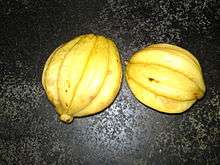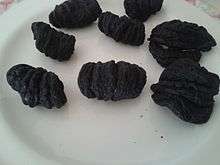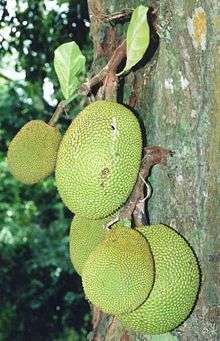Garcinia gummi-gutta
| Garcinia gummi-gutta | |
|---|---|
| | |
| Scientific classification | |
| Kingdom: | Plantae |
| (unranked): | Angiosperms |
| (unranked): | Eudicots |
| (unranked): | Rosids |
| Order: | Malpighiales |
| Family: | Clusiaceae |
| Genus: | Garcinia |
| Species: | G. gummi-gutta |
| Binomial name | |
| Garcinia gummi-gutta (L.) Roxb. | |
| Synonyms[1] | |
| |
Garcinia gummi-gutta is a tropical[2] species of Garcinia native to Indonesia. Common names include Garcinia cambogia (a former scientific name), as well as brindleberry,[3] Malabar tamarind,[2] and kudam puli (pot tamarind).[4] This fruit looks like a small pumpkin and is green to pale yellow in color.
Although it has received considerable media attention purporting its effects on weight loss, there is liver toxicity associated with commercial preparations of the fruit extract[5] with clinical evidence indicating it has no significant effect on weight loss.[6]
Cultivation

Garcinia gummi-gutta is grown for its fruit in Southeast Asia, coastal Karnataka/Kerala, India, and west and central Africa. It thrives in most moist forests.
G. gummi-gutta is one of several closely related Garcinia species from the plant family Clusiaceae.[7] With thin skin and deep vertical lobes, the fruit of G. gummi-gutta and related species range from about the size of an orange to that of a grapefruit; G. gummi-gutta looks more like a small yellowish, greenish, or sometimes reddish pumpkin.[8] The color can vary considerably. When the rinds are dried and cured in preparation for storage and extraction, they are dark brown or black in color.
Along the west coast of South India, G. gummi-gutta is popularly termed "Malabar tamarind", and shares culinary uses with the tamarind (Tamarindus indica). The latter is a small and the former a quite large evergreen tree. G. gummi-gutta is also called goraka or, in some areas, simply kattcha puli (souring fruit). It is called uppage in Kannada language and fruits are collected and dried for selling to dealers in Sirsi, Karnataka.[9]
Uses
Cooking
G. gummi-gutta is used in cooking, including in the preparation of curries. The fruit rind and extracts of Garcinia species are called for in many traditional recipes,[10] and various species of Garcinia are used similarly in food preparation in Assam (India), Thailand, Malaysia, Burma, and other Southeast Asian countries. In the Indian Ayurvedic medicine, "sour" flavors are said to activate digestion. The extract and rind of G. gummi-gutta is a curry condiment in India.[4][10][11][12] It is an essential souring ingredient in the southern Thai variant of kaeng som, a sour curry.[13][14]
G. gummi-gutta is used commercially in fish curing, especially in Sri Lanka and South India. The trees can be found in forested areas and also are protected in plantations otherwise given over to pepper, spice, and coffee production.
Weight loss
Hydroxycitric acid (HCA), the principle constituent (10-50%) of the dried fruit rind of Garcinia cambogia, has been assessed for its potential to cause weight loss.[15] In late 2012, a United States television personality, Dr. Oz, promoted Garcinia cambogia extract as "an exciting breakthrough in natural weight loss".[16][17] Dr. Oz's endorsements of dietary supplements having no or little scientific evicence of efficacy have often led to a substantial increase in consumer purchases of the promoted products.[17]
However, medical evidence is lacking, and the results of clinical trials do not strongly support claims that extracts derived from Garcinia cambogia are effective weight-loss aids.[18][19][20][21] Meta-analyses of clinical trials offers evidence for limited short term weight loss with increases of up to two-fold in adverse events.[6][22] A 1998 randomized, controlled trial looked at the effects of hydroxycitric acid, the purported active component in G. gummi-gutta, as a potential antiobesity agent in 135 people. The conclusion from this trial was that Garcinia cambogia failed to produce significant weight loss and fat mass loss beyond that observed with placebo.[18] A more recent report stated that a meta-analysis, had clear limitations, suggesting:
…a small, statistically significant difference in weight loss favouring HCA over placebo (MD: −0.88 kg; 95% CI: −1.75, −0.00). [but with] Gastrointestinal adverse events… twice as common in the HCA group compared with placebo in one included study… [leading them to conclude that while] ...Garcinia extracts/HCA can cause short-term weight loss. The magnitude of the effect is small, and the clinical relevance is uncertain.[6]
Further, adverse events associated with use of such supplements ("side effects") — especially, hepatotoxicity, as well as gastrointestinal issues — led to one preparation being withdrawn from the market.[5][23]
While it has received considerable media attention purporting impact on weight loss, the limited clinical evidence for Garcinia cambogia supports no clear effect,[18] while gastrointestinal adverse events were two-fold more common over the placebo in a 2011 meta-analysis indicating the extract may be unsafe for human consumption.[6]
Adverse effects
Orally, 500 mg of hydroxycitric acid four times daily can cause nausea, gastrointestinal discomfort, and headaches.[24]
Drug Interactions

There have been several case reports of patients developing "Serotonin Syndrome" after combining their serotonergic medicines with Garcinia cambogia.[25] Caution should be exercised in patients treated with the following class of medications who are looking to manage their weight issue using Garcinia cambogia:
- SSRIs: such as Fluoxetine, Paroxetine, Escitalopram and Sertraline
- Tricyclic Antidepressant (TCAs): Doxepine, Amitriptyline, etc
- Dextromethorphan: a common cough suppresant found in many cough syrups and cold&flu remedies.
- Pethidine
- Pentazocine
- Tramadol
References
- ↑ "Garcinia gummi-gutta (L.) Roxb.". World Checklist of Selected Plant Families (WCSP). Royal Botanic Gardens, Kew. Retrieved 1 June 2013 – via The Plant List.
- 1 2 "USDA GRIN Taxonomy".
- ↑ "Potential treatments for insulin resistance in the horse: A comparative multi-species review". The Veterinary Journal. Science Direct. 186: 282–291. doi:10.1016/j.tvjl.2009.08.032. Retrieved 6 October 2013.
- 1 2 "Meals that heal - Soul curry". The Hindu. Retrieved 3 October 2013.
- 1 2 Lobb, A. (2009). "Hepatoxicity associated with weight-loss supplements: A case for better post-marketing surveillance". World Journal of Gastroenterology. 15 (14): 1786–1787. doi:10.3748/wjg.15.1786. PMC 2668789
 . PMID 19360927.
. PMID 19360927. - 1 2 3 4 Onakpoya, Igho; Hung, Shao Kang; Perry, Rachel; Wider, Barbara; and Ernst, Edzard (2011). "The Use of Garcinia Extract (Hydroxycitric Acid) as a Weight loss Supplement: A Systematic Review and Meta-Analysis of Randomised Clinical Trials". Journal of Obesity (December 14): 509038. doi:10.1155/2011/509038. PMC 3010674
 .
. - ↑ Publications & Information Directorate, Council of Scientific & Industrial Research (1986). G. cambogia Desr. The Useful Plants of India. (New Delhi: Publications & Information Directorate, 1986) 229.
- ↑ "Fruit yellowish or reddish, size of an orange having six or eight deep longitudinal grooves in its fleshy pericarp. Pulp acid of a pleasant flavor. It is dried among the Singalese who use it in curries." Uphof, J.C. Th. (1968).
- ↑ Rajeswari, N (29 July 2014). "Botanical Bonanza". Deccan Herald, Spectrum. Retrieved 29 July 2014.
- 1 2 "The acid rinds of the ripe fruit are eaten, and in Ceylon are dried, and eaten as a condiment in curries." Drury, Heber (1873). "Garcinia gambogia (Desrous) N. 0. Clusiaceae". The Useful Plants of India, second edition. London: William H. Allen & Co. p. 220.
- ↑ "G. Gummi-Gutta (Garcinia Cambogia) – An Ancient Indian Curry Condiment". US Premium Garcinia Cambogia. Retrieved 5 May 2015.
- ↑ "Kudampuli meencurry (fish curry with Malabar tamarind)". Secret Indian Recipe. Retrieved 5 May 2015.
- ↑ "Kaeng Som Kung (Sour Curry with Shrimp)". Saveur. 26 February 2015. Retrieved 5 May 2015.
- ↑ "Gaeng Som Recipe, Thai Sour Curry Recipe of Shrimp, Okra and Roselle Leaves". Thai Food Master. 30 March 2011. Retrieved 5 May 2015.
- ↑ Heymsfield, SB (1998). "Garcinia cambogia (hydroxycitric acid) as a potential antiobesity agent: a randomized controlled trial". JAMA. 280 (18): 1596–600. PMID 9820262.
- ↑ The Dr. Oz Show (November 5, 2012). Garcinia Cambogia: The Newest, Fastest Fat-Buster.
- 1 2 Christensen, Jen and Wilson Jacque (19 June 2014). "Congressional hearing investigates Dr. Oz 'miracle' weight loss claims". CNN Health. Retrieved 18 September 2016.
- 1 2 3 Heymsfield, S. B.; Allison, D. B.; Vasselli, J. R.; Pietrobelli, A.; Greenfield, D.; Nunez, C. (1998). "Garcinia cambogia (Hydroxycitric Acid) as a Potential Antiobesity Agent: A Randomized Controlled Trial". J. Amer. Med. Assoc. 280 (18): 1596–1600. doi:10.1001/jama.280.18.1596. PMID 9820262. Retrieved 14 September 2016.
- ↑ Márquez F1, Babio N, Bulló M, Salas-Salvadó J (2012). "Evaluation of the safety and efficacy of hydroxycitric acid or Garcinia cambogia extracts in humans". Crit Rev Food Sci Nutr. 52 (7): 585–94. doi:10.1080/10408398.2010.500551. PMID 22530711.
- ↑ Vasques, C. A.; Schneider, R; Klein-Júnior, L. C.; Falavigna, A; Piazza, I; Rossetto, S (2013). "Hypolipemic Effect of Garcinia cambogia in Obese Women". Phytotherapy Research. 28 (6): 887–91. doi:10.1002/ptr.5076. PMID 24133059.
- ↑ Belluz, Julia; Hoffman, Steven J. (1 January 2013). "Dr. Oz's Miraculous Medical Advice; Pay no attention to that man behind the curtain". Slate. The Slate Group. Retrieved 31 May 2013.
- ↑ Pittler, M. H.; Ernst, E (2004). "Dietary supplements for body-weight reduction: A systematic review". The American Journal of Clinical Nutrition. 79 (4): 529–36. PMID 15051593.
- ↑ Kim YJ1, Choi MS, Park YB, Kim SR, Lee MK, Jung UJ (2013). "Garcinia Cambogia attenuates diet-induced adiposity but exacerbates hepatic collagen accumulation and inflammation". World J Gastroenterol. 19 (29): 4689–701. doi:10.3748/wjg.v19.i29.4689. PMC 3732841
 . PMID 23922466.
. PMID 23922466. - ↑ Soni, MG (2004). "Safety assessment of (-)-hydroxycitric acid and Super CitriMax, a novel calcium/potassium salt.". Food Chem Toxicol. 42 (9). doi:10.1016/j.fct.2004.04.014. PMID 15234082.
- ↑ Lopez, AM (2014). "Serotonin toxicity associated with Garcinia cambogia over-the-counter supplement.". J Med Toxicol. 10 (4). doi:10.1007/s13181-014-0390-7. PMID 24699886.
External resources
| Wikimedia Commons has media related to Garcinia gummi-gutta. |

